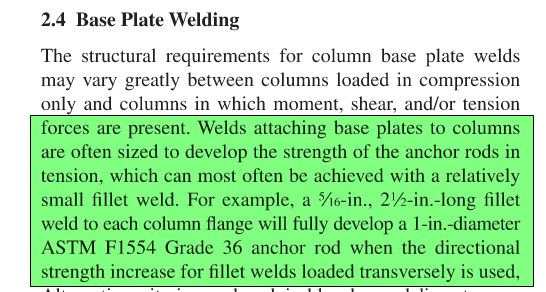Samwise Gamgee
Structural
I have a base plate with (8) 1" anchor rods. The weld between the base plate and column is adequate to take Shear load of 60kips and uplift of 20kip. I have a 1/4" weld all round weld for a HSS8x8x = 1.392*4*30" = 171 kips.
The baseplate design guide says the weld capacity needs to be able to develop the strength of anchor rods in tension. One anchor rod (1" Dia. F1554 , 58ksi) tensile capacity is 0.75*58*0.7785 = 34.2k. So does the weld need to be able to develop the tension capacity of all 8 anchors which would be 34.2*8 = 274kips ? For which I would a weld as big as 7/16". This seems to be unreasonable, any thoughts? Or should the weld be able to just develop tensile capacity of one anchor?
The baseplate design guide says the weld capacity needs to be able to develop the strength of anchor rods in tension. One anchor rod (1" Dia. F1554 , 58ksi) tensile capacity is 0.75*58*0.7785 = 34.2k. So does the weld need to be able to develop the tension capacity of all 8 anchors which would be 34.2*8 = 274kips ? For which I would a weld as big as 7/16". This seems to be unreasonable, any thoughts? Or should the weld be able to just develop tensile capacity of one anchor?


